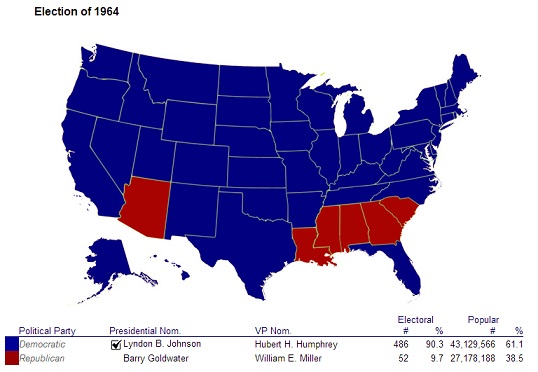
In the 1964 race for the presidency, the Lyndon Johnson campaign aired an ad known as the Daisy Girl Advertisement. Even by today's standards, the ad was blatantly manipulative and preyed on the public's fear of nuclear war. The ad was only aired once but got so much exposure from the news media and had so much power that it single-handedly turned the tide of the election to a Johnson landslide. Is this type of political advertising justified? The problem is - it works!
The year was 1964. Kennedy had recently been assassinated, and now Lyndon Johnson was running to prove that he was worthy of the office of President, not just a shadow of the country's beloved Kennedy. Running against Johnson was Barry Goldwater, who was far to the right of many people's comfort level. Right or wrong, there was a perception that Goldwater would start a nuclear war if elected President. The Johnson campaign hired a Madison Avenue ad agency to exploit the public's fear, and they came up with "Peace Little Girl" or what is now known as the Daisy Girl Advertisement.
The ad depicts a little girl counting the petals of a daisy. When she reaches nine after miscounting several times, an ominous voice begins a countdown from 10 down to 1 finishing with the devastating explosion and mushroom cloud of a nuclear bomb. Johnson's voice comes in right after the explosion.
These are the stakes. To make a world in which all of God's children can live. Or to go into the dark. We must either love each other or we must die.
Then an announcer comes in.
Vote for President Johnson on November 3. The stakes are too high for you to stay home.
Goldwater is never mentioned in the ad. There was a great deal of controversy, and the Johnson campaign withdrew the ad after having aired it only once. But the damage was done. It was replayed on the news over and over, and the daisy girl appeared on the cover of Time magazine. Many believe the ad was a big contributor to the Johnson landslide.
The Daisy Girl ad was the first political ad to blatantly manipulate people's emotions. I'm sure the campaign and ad creators were shocked at how well it worked. They learned that the best way to sway people's opinions was to skip over logic, issues, and information, and go right for their fear. In other words, if the public is afraid of the other guy they'll surely vote for our guy. This trick will later be used over and over in political campaigns and all kinds of campaigns that attempt to sway public opinion. The means used to make us afraid of something include whatever distortions, exaggerations, half-truths, and outright lies are necessary. Even after the lies are exposed, the ads usually work. We'd rather vote for a liar than whatever he or she has depicted the other guy as. I believe truth and integrity do have a place in political campaigns, but clearly the candidates place a higher value on winning.
The ironic thing about the Daisy Girl affair is it was executed by Johnson, a liberal Democrat. So much of my thesis center around the conservatives using lies, manipulation, and fear mongering. The liberals are just as capable of using these techniques because they work.









CAROL
This is an awesome lesson. I remember that election. But I don’t remember the ad. What an incredibly excellent example of PROPAGANDA. There are so many examples of it today, with the internet, it’s so easy for these kinds of public manipulation to go viral. The real danger is that people cannot/do not distinguish propaganda from fact.
MAILLOT DE FOOT
I like this post, enjoyed this one appreciate it for putting up.